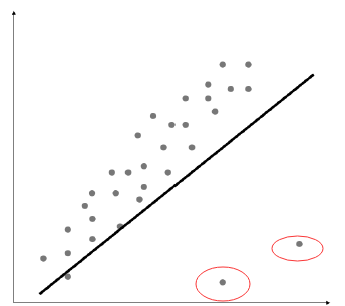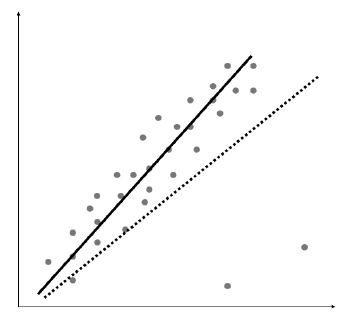版权声明:原创未经允许不得转载,转载请附链接 https://blog.csdn.net/weixin_40640020/article/details/88697715
continuing。。。。。。。。。。。。。。
- 创建岭回归器
线性回归的主要问题是对异常值敏感。在真实世界的数据收集过程中,经常会遇到错误的度
量结果。而线性回归使用的普通最小二乘法,其目标是使平方误差最小化。这时,由于异常值误差的绝对值很大,因此会引起问题,从而破坏整个模型。例如下图

红色圆圈所圈点为数据的奇异点
右下角的两个数据点明显是异常值,但是这个模型需要拟合所有的数据点,因此导致整个模
型都错了。仅凭直觉观察,我们就会觉得如下图的拟合结果更好。

普通最小二乘法在建模时会考虑每个数据点的影响,因此,最终模型就会像上图显示的直线那样。显然,我们发现这个模型不是最优的。为了避免这个问题,我们引入正则化项的系数作为阈值来消除异常值的影响。这个方法被称为岭回归。
# -*- coding: utf-8 -*-
"""
Created on Fri Mar 30 17:01:42 2018
@author: imace
"""
import numpy as np
X = []
y = []
with open('C://Users/imace/Desktop/python_execise/Chapter01/data_multivar.txt'
, 'r') as f:
for line in f.readlines():
data = [float(i) for i in line.split(',')]
xt, yt = data[:-1], data[-1]
X.append(xt)
y.append(yt)
# Train/test split
num_training = int(0.8 * len(X))
num_test = len(X) - num_training
# Training data
#X_train = np.array(X[:num_training]).reshape((num_training,1))
X_train = np.array(X[:num_training])
y_train = np.array(y[:num_training])
# Test data
#X_test = np.array(X[num_training:]).reshape((num_test,1))
X_test = np.array(X[num_training:])
y_test = np.array(y[num_training:])
# Create linear regression object
from sklearn import linear_model
linear_regressor = linear_model.LinearRegression()
ridge_regressor = linear_model.Ridge(alpha=0.01, fit_intercept=True, max_iter=10000)
# Train the model using the training sets
linear_regressor.fit(X_train, y_train)
ridge_regressor.fit(X_train, y_train)
# Predict the output
y_test_pred = linear_regressor.predict(X_test)
y_test_pred_ridge = ridge_regressor.predict(X_test)
# Measure performance
import sklearn.metrics as sm
print ("LINEAR:")
print ("Mean absolute error =", round(sm.mean_absolute_error(y_test, y_test_pred), 2) )
print ("Mean squared error =", round(sm.mean_squared_error(y_test, y_test_pred), 2) )
print ("Median absolute error =", round(sm.median_absolute_error(y_test, y_test_pred), 2) )
print ("Explained variance score =", round(sm.explained_variance_score(y_test, y_test_pred), 2) )
print ("R2 score =", round(sm.r2_score(y_test, y_test_pred), 2))
print ("\nRIDGE:")
print ("Mean absolute error =", round(sm.mean_absolute_error(y_test, y_test_pred_ridge), 2) )
print ("Mean squared error =", round(sm.mean_squared_error(y_test, y_test_pred_ridge), 2) )
print ("Median absolute error =", round(sm.median_absolute_error(y_test, y_test_pred_ridge), 2) )
print ("Explained variance score =", round(sm.explained_variance_score(y_test, y_test_pred_ridge), 2) )
print ("R2 score =", round(sm.r2_score(y_test, y_test_pred_ridge), 2))
# Polynomial regression
from sklearn.preprocessing import PolynomialFeatures
polynomial = PolynomialFeatures(degree=10)
X_train_transformed = polynomial.fit_transform(X_train)
datapoint = np.array([0.39,2.78,7.11]).reshape(1,-1)
poly_datapoint = polynomial.fit_transform(datapoint)
poly_linear_model = linear_model.LinearRegression()
poly_linear_model.fit(X_train_transformed, y_train)
print ("\nLinear regression:\n", linear_regressor.predict(datapoint))
print ("\nPolynomial regression:\n", poly_linear_model.predict(poly_datapoint))
# Stochastic Gradient Descent regressor
sgd_regressor = linear_model.SGDRegressor(loss='huber', n_iter=50)
sgd_regressor.fit(X_train, y_train)
print ("\nSGD regressor:\n", sgd_regressor.predict(datapoint))
补充:
atapoint = np.array([0.39,2.78,7.11]).reshape(1,-1)
print(datapoint)
输出一行
[[0.39 2.78 7.11]]
datapoint = np.array([0.39,2.78,7.11]).reshape(-1,1)
print(datapoint)
输出一列
[[0.39]
[2.78]
[7.11]]
程序输出结果为
LINEAR:
Mean absolute error = 3.95
Mean squared error = 23.15
Median absolute error = 3.69
Explained variance score = 0.84
R2 score = 0.83
RIDGE:
Mean absolute error = 3.95
Mean squared error = 23.15
Median absolute error = 3.69
Explained variance score = 0.84
R2 score = 0.83
Linear regression:
[-11.0587295]
Polynomial regression:
[-8.14917282]
SGD regressor:
[-7.93671074]
从上边的结果来看两种算法所得的结果一样,即线性回归和岭回归算法所得的结果一样。
编辑于 2019-03-20